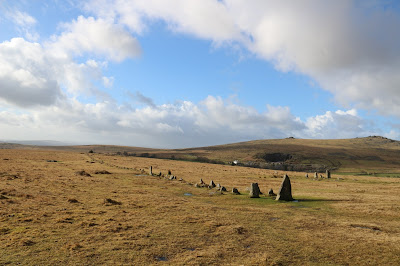 |
| The River Walkham in full spate, with an interesting collection of pipes taking water off for use elsewhere (contrast with the Long Ash leat mentioned later on). |
 |
| No greenery in the canopy but plenty of green below. |
 |
| Moss covered rocks everywhere, giving a lush verdant appearance to the woods. |
 |
| In the far distance we can make out Kit Hill. It's about 15 miles from where we were standing. |
 |
| Trying to figure out the best way to cross this particular stream. And it wasn't the spot being studiously considered |
 |
| On the edge of Merrivale Common is this standing stone. It's got T carved on one side..... |
 |
| Looking down the southern of the two double stone rows. Each is about 1/2 mile long. What was their function? Nobody really knows. Ceremonial? Ancient chronometer? Tribal capital? |















No comments:
Post a Comment